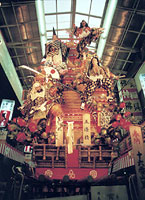|
|
|||||||
|
|
|||||||
|
|||||||
| | Web Japan >>| Trends in Japan >> | Arts & Entertainment >> | Rites of Summer | |
|
RITES OF SUMMER Shrine-Carrying Competition Marks Season in Fukuoka (June 27, 2003) The sky in the east becomes light at 4:59 AM on July 15, and the sound of a taiko drum can be heard coming from Kushida Shrine in Fukuoka City's Hakata Ward. The ground trembles as massive portable shrines called kakiyama are carried through the streets by dozens of men dressed in happi coats. After going halfway around a flag in the middle of the shrine precincts, the men carrying the kakiyama come to a halt. They sing a celebratory song and then rush out into the streets of Hakata. The course they will follow is about 5 kilometers (3.1 miles) long, and each kakiyama weighs about 1 ton. While racing to the goal as fast as they can, the men yell the traditional chant of "Oissa! Oissa!" and call out to each other.
Yamakasa has a long history. It is said that the festival began in the Kamakura period (1192-1333) when a high-ranking priest was carried around the city to ward off the plague in 1241. The parent organizations of the seven kakiyama are called nagare, which are composed of neighborhood associations. They take this name from the seven subdivisions of the old city of Hakata. For the townspeople that belong to nagare, it is considered an honor to carry the kakiyama, and the competition in the 5-kilometer race is intense. Last year the Chiyo Nagare team won, and they hope to repeat as champions this year. The other six teams are training and working on strategies to bring Chiyo Nagare's reign to an end.
More Than 3 Million Come to Watch Fukuoka City, the home of Gion Yamakasa, has a population of 1.34 million and is the largest city on the island of Kyushu. Hakata, which occupies a central location in the city, was an important port in the Nara (710-794) and Heian (794-1192) periods, and it prospered as the gateway to the Asian mainland. It is the port that Japanese emissaries used when they traveled abroad on journeys to bring back Buddhism, culture, and antiquities. In 664 the city of Dazaifu was built there by the government on a one-third scale of the capital city at the time, Heijokyo (now Nara). In addition to managing Kyushu, the government officials at Dazaifu were responsible for the nation's defense and diplomacy. Later, Hakata was designated a free market by Toyotomi Hideyoshi (1537-1598), who had succeeded in unifying Japan. Hakata merchants enjoyed autonomy and prospered as they conducted trade with China, the Korean Peninsula, the Ryukyu Islands (now Okinawa), and the South Pacific. Hakata came to rival Sakai (located in present-day Osaka Prefecture), which was Japan's largest port of international trade at the time. Even today, Fukuoka is a stopping-off point for many tourists coming to Japan from other Asian countries and is continuing its development as an international city. Related Web SitesQ-Shu My Concierge (Japanese and Korean only) Copyright (c) 2004 Web Japan. Edited by Japan Echo Inc. based on domestic Japanese news sources. Articles presented here are offered for reference purposes and do not necessarily represent the policy or views of the Japanese Government. |
DANCING IN THE STREETS (August 13, 2003) MIDSUMMER NIGHTS' REVELRY (July 22, 2003) HEAVENLY HOKKAIDO (June 2, 2003) |
|
|




